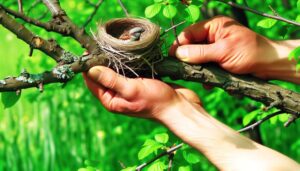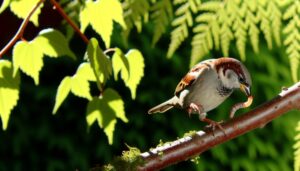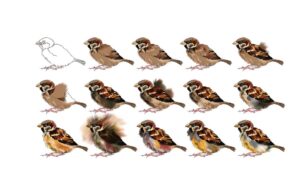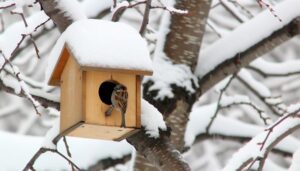Build a House Sparrow Trap in 3 Easy Steps
Constructing a house sparrow trap involves meticulous planning and execution. Begin by utilizing galvanized wire mesh and treated timber for longevity.
Build a sturdy frame, making sure all connections are secure. Fasten a mesh with openings no larger than 1/2 inch using heavy-duty staples.
Install a door mechanism with galvanized steel or high-density plastic, integrating a spring-loaded latch for secure closure. Place the trap near food sources, sheltered areas, or water sources.
Use non-toxic bait that imitates natural food sources, evenly dispersed. Checking every 1-2 hours ensures humane trapping.
Explore further for detailed steps and in-depth methodologies.
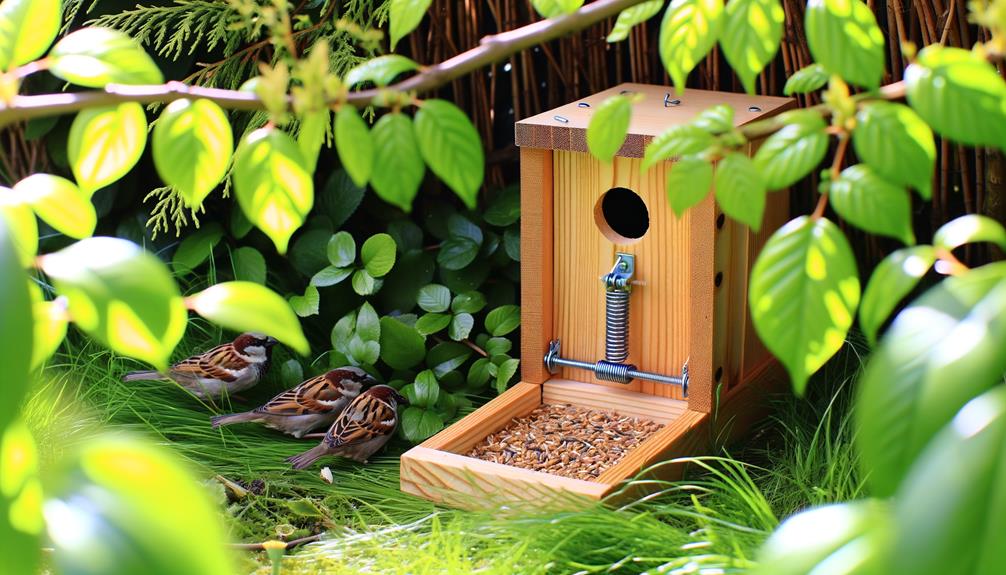
Key Takeaways
- Use galvanized wire mesh and treated lumber for a durable, weather-resistant trap frame.
- Ensure mesh openings are no larger than 1/2 inch to securely contain sparrows.
- Install a spring-loaded or gravity-based locking door mechanism made from corrosion-resistant materials.
- Place traps near food sources, water, and sheltered areas for optimal sparrow attraction.
- Regularly monitor and refresh bait to maximize capture rates and ensure humane operation.
Understanding Sparrow Behavior
Understanding the behavior of house sparrows (Passer domesticus) is vital for designing an effective trap, as their feeding patterns, social interactions, and nesting habits directly influence trap placement and bait selection.
House sparrows exhibit diurnal activity, with peak feeding times during early morning and late afternoon. They mainly forage on the ground, consuming seeds, grains, and insects.
Socially, sparrows are gregarious, often forming flocks, which indicates that traps should be placed in areas with high sparrow congregation.
Nesting occurs in cavities or sheltered locations, suggesting potential trap sites near buildings or dense vegetation.
Incorporating these behavioral insights ensures that the trap is positioned strategically and baited effectively, increasing the likelihood of successful capture.
Selecting Materials
Choosing the appropriate materials for constructing a house sparrow trap is critical for guaranteeing durability, effectiveness, and humane capture. It is important to select components that withstand environmental conditions and maintain structural integrity over time. High-quality materials minimize maintenance and maximize the trap's lifespan.
Here are essential materials required:
- Galvanized Wire Mesh: Guarantees robustness and prevents rusting, facilitating long-term use.
- Plywood or Treated Lumber: Provides a sturdy frame while resisting decay and pests.
- Springs and Hinges: Necessary for creating responsive, reliable trap doors.
- Plastic Sheeting: Used for weatherproofing, enhancing the trap's resilience.
- Non-toxic Bait: Attracts sparrows without harming other wildlife.
These materials collectively contribute to building an efficient, humane, and durable house sparrow trap.
Designing the Trap
Designing the trap necessitates meticulous selection of appropriate materials, ensuring structural integrity and durability.
Constructing the frame requires precise measurements and assembly techniques to create an effective enclosure.
Incorporating a bait mechanism is essential for attracting house sparrows, necessitating strategic placement and reliable activation.
Choosing Trap Materials
Selecting appropriate materials is essential for the efficacy and durability of a house sparrow trap, making sure it withstands environmental conditions and repeated use. The choice of materials impacts not only the structural integrity but also the operational efficiency of the trap.
Here are key considerations when selecting materials:
- Weather Resistance: Opt for materials like galvanized steel or treated wood to prevent degradation from moisture and UV exposure.
- Weight: Use lightweight yet sturdy materials such as aluminum for ease of transport and setup.
- Mesh Size: Choose wire mesh with appropriate spacing, typically 1/2-inch, to prevent sparrows from escaping while allowing ventilation.
- Non-toxic Coatings: Make certain all materials are coated with non-toxic finishes to avoid harming the birds.
- Durability: Select high-tensile strength materials to enhance the lifespan of the trap under repetitive use.
Constructing the Frame
The initial step in constructing the frame of a house sparrow trap involves precise measurements and cutting of the selected materials to guarantee structural integrity and best functionality. Begin by selecting robust, weather-resistant wood or metal for the frame.
Measure and cut four vertical supports, each 50 cm in length, to form the corners. Next, cut eight horizontal beams—four at 30 cm for the top and bottom widths, and four at 40 cm for the depth. Utilize a carpenter's square to secure accurate right angles during assembly.
Secure the beams with galvanized screws to prevent corrosion. Confirm all joints are tightly fitted to avoid structural weaknesses, as any instability could compromise the trap's effectiveness in capturing house sparrows.
Adding Bait Mechanism
Incorporating an efficient bait mechanism is crucial for promoting the successful capture of house sparrows within the constructed frame. The bait mechanism must be meticulously designed to attract sparrows while minimizing interference from non-target species.
Key considerations include:
- Bait Selection: Ideal choices include millet or cracked corn, which house sparrows find irresistible.
- Placement: Position bait centrally to entice sparrows into the trap.
- Dispensing System: Utilize a gravity-fed dispenser to maintain a consistent bait supply.
- Protection: Shield bait from environmental elements such as rain to preserve its attractiveness.
- Monitoring: Regularly inspect and replenish bait to ensure ongoing effectiveness.
These factors collectively enhance the trap's efficiency, leading to a higher capture rate and efficient management of house sparrow populations.
Building the Frame
To commence the construction of the frame, it is crucial to select materials that offer both durability and ease of manipulation, such as treated pine or marine-grade plywood.
Precise measurements should be taken to guarantee uniformity, followed by accurate cutting of the wood to exact specifications.
The assembly process involves securely fastening the cut pieces using appropriate hardware to construct a stable and functional frame for the trap.
Choosing Suitable Materials
Selecting durable and weather-resistant materials is necessary for constructing a long-lasting frame for the house sparrow trap. Best material selection enhances the structural integrity and longevity of the trap, ensuring it withstands various environmental conditions.
Consider the following materials:
- Pressure-treated lumber: Resists decay and insect damage, providing long-term sturdiness.
- Marine-grade plywood: Offers superior water resistance, optimal for outdoor use.
- Galvanized steel mesh: Prevents rust and corrosion, maintaining trap efficacy.
- Stainless steel screws: Provide strong connections, minimizing the risk of frame disintegration.
- Outdoor-rated wood sealant: Adds an additional layer of protection against moisture and UV damage.
Measuring and Cutting Wood
Accurate measurements and precise cutting are fundamental for constructing a sturdy and dependable frame for the house sparrow trap.
Begin by selecting wood pieces with uniform thickness and minimal warping. Utilize a measuring tape to mark dimensions accurately, guaranteeing each piece adheres to the design specifications.
Employ a carpenter's square to verify right angles, enhancing structural integrity.
A fine-toothed saw or a powered miter saw is recommended for cutting, as it secures clean, straight edges. Each cut should be deliberate and methodical, reducing the risk of material wastage.
Sand the edges lightly to remove splinters, promoting safer handling and assembly.
Following these meticulous methods guarantees the formation of a precise, functional frame for the house sparrow trap.
Assembling the Frame
With all wood pieces accurately cut and prepared, the next phase involves methodically assembling the frame to guarantee structural stability and functional integrity. Begin by aligning the base and side panels, establishing right-angle connections. Utilize wood glue at each joint to enhance the bond, followed by securing with screws for added strength.
Key steps include:
- Aligning joints: Confirm all corners meet at precise angles to maintain geometric accuracy.
- Using clamps: Temporarily hold pieces in place while the adhesive cures.
- Pre-drilling holes: Prevents wood from splitting when inserting screws.
- Verifying measurements: Regularly measure to confirm dimensions remain consistent.
- Applying even pressure: Ensures a uniform connection across all joints.
This systematic approach secures the frame's durability, providing a robust foundation for subsequent trap components.
Adding the Mesh
Securing the structural integrity of the trap is crucial to prevent any potential escape routes for the house sparrows. The mesh should be accurately measured and firmly attached to the frame. Utilize galvanized wire mesh with openings no larger than 1/2 inch to guarantee containment. Carefully trim the mesh to match the dimensions of the frame, allowing for slight overlaps at the edges to provide extra security.
Use heavy-duty staples or galvanized nails to secure the mesh, maintaining uniform spacing to prevent weak points. Inspect the perimeter thoroughly to ensure that no sharp edges or openings are present, which could undermine the trap's effectiveness. This thorough approach ensures that the mesh will endure various environmental conditions while securely housing the sparrows.
Installing the Door Mechanism
When installing the door mechanism, it is imperative to select materials that combine durability with ease of operation, such as galvanized steel or high-density plastic.
The door must be positioned to allow smooth, unobstructed movement, typically at the entry point of the trap.
Ensuring a secure closure can be achieved through the use of a spring-loaded latch or a gravity-based locking system, preventing any unintended escapes.
Selecting Suitable Materials
Choosing the most appropriate materials for installing the door mechanism is crucial to secure the trap's reliability and functionality. The selection process must consider mechanical resilience, environmental durability, and ease of installation.
Critical material attributes include:
- Corrosion Resistance: Opt for stainless steel or aluminum to prevent rusting and secure longevity.
- Strength and Rigidity: Use materials that can withstand repeated impacts without deforming, such as hardwood or reinforced plastic.
- Smooth Operation: Choose materials with low friction coefficients to facilitate seamless door movement.
- Weather Resistance: Secure materials can endure varying weather conditions without degrading.
- Non-Toxicity: Select safe, non-hazardous materials to avoid harming the sparrows or other wildlife.
This thorough selection secures the efficacy and humane functionality of the sparrow trap.
Door Positioning Techniques
Proper alignment of the door mechanism is crucial to guaranteeing the trap operates effectively and humanely. The door must be positioned to allow seamless entry and automatic closure upon activation. The following table outlines the essential steps and considerations for precise door positioning:
| Step | Description |
|---|---|
| 1 | Measure the door frame precisely to secure a snug fit without friction. |
| 2 | Install hinges at equidistant points to enable smooth pivot action. |
| 3 | Attach a spring mechanism calibrated to close the door gently yet firmly. |
| 4 | Confirm the door is level horizontally and vertically to prevent misalignment. |
| 5 | Test the door multiple times to verify consistent operation. |
These steps will secure the door operates smoothly and effectively, reducing stress on captured sparrows.
Ensuring Secure Closure
To secure closure of the trap, the door mechanism must be meticulously installed with attention to both functionality and reliability. Securing the door operates seamlessly involves several critical steps:
- Alignment Precision: Secure the door aligns perfectly with the frame to prevent gaps.
- Spring Tension: Adjust springs to provide sufficient force for rapid closure without causing damage.
- Latch Mechanism: Install a reliable latch that engages securely upon closure to prevent escape.
- Material Durability: Use corrosion-resistant materials to withstand environmental conditions.
- Ease of Reset: Design the door mechanism for straightforward resetting to facilitate repeated use.
Adhering to these detailed observations will secure the house sparrow trap operates effectively, maintaining both the integrity and the humane treatment of the captured birds.
Setting Up the Bait
Effective bait placement is crucial for maximizing the capture rate of house sparrows in your trap.
To attract these avian subjects, use a bait that mimics their natural food sources; millet, cracked corn, and sunflower seeds are highly effective.
Distribute the bait uniformly across the trap floor to encourage entry. Ensure the bait is visible from outside the trap, as sparrows rely on visual cues to locate food.
Avoid over-saturating the area with bait, as this may deter the birds from entering the trap. Regularly refresh the bait to maintain its appeal, preventing it from becoming stale or contaminated.
Careful attention to these details will greatly enhance the effectiveness of your house sparrow trapping efforts.
Placing the Trap
Best trap placement is vital for the successful capture of house sparrows, requiring strategic positioning in areas with high avian activity and minimal human disturbance. Optimum locations are essential to maximize capture rates and minimize stress on the birds.
Key considerations include:
- Proximity to food sources: Place traps near bird feeders or gardens where sparrows frequently forage.
- Sheltered areas: Position traps in locations providing some protection from the elements, increasing bird comfort and reducing trap visibility.
- Elevation: Set traps at ground level or slightly raised to align with natural sparrow foraging behavior.
- Visibility: Ensure traps are noticeable to sparrows but not to potential predators or human interference.
- Access to water: Situate traps near water sources, as sparrows require regular hydration.
Adhering to these guidelines enhances the likelihood of effective and compassionate trapping.
Monitoring the Trap
Continuous observation is essential to guarantee the humane and efficient operation of house sparrow traps. Regular monitoring ensures that non-target species are promptly released, and trapped sparrows are not subject to undue stress or harm.
It is recommended to inspect the trap every 1-2 hours during daylight, as sparrows are diurnal. Utilize binoculars for distant observations to avoid disturbing the trap area. Documentation of each inspection, including time, weather conditions, and any captured species, can provide vital data for optimizing trap placement and timing.
If a sparrow is captured, immediate actions must be taken to minimize distress. Consistent monitoring also helps in identifying and rectifying any mechanical failures or bait depletion, thereby maintaining trap efficacy.
Safely Relocating Sparrows
Securing the humane and safe relocation of captured house sparrows involves meticulous handling procedures to minimize stress and prevent injury to the birds. This process requires the following considerations:
- Appropriate Containment: Use well-ventilated, escape-proof containers to temporarily house the sparrows.
- Handling Methods: Employ gentle, consistent handling to reduce the risk of physical trauma and stress-induced behaviors.
- Ideal Release Sites: Select relocation areas with adequate food sources, shelter, and minimal predation risk.
- Timing: Relocate birds during cooler parts of the day to prevent heat-related stress.
- Observation Post-Release: Monitor the sparrows post-release to guarantee successful adaptation to the new environment.
Conclusion
To sum up, constructing a house sparrow trap requires understanding sparrow behavior, selecting appropriate materials, designing an effective trap, building a sturdy frame, adding secure mesh, setting up enticing bait, strategically placing the trap, and diligently monitoring the results.
Each step demands meticulous attention to detail, precise execution, and consistent observation to guarantee humane relocation. The integrated approach guarantees effectiveness while adhering to ethical standards, thereby accomplishing the goal of safely managing sparrow populations.

